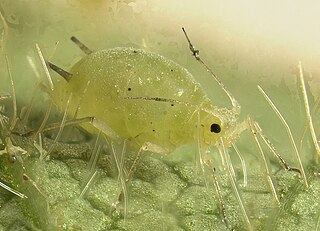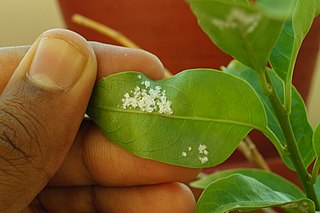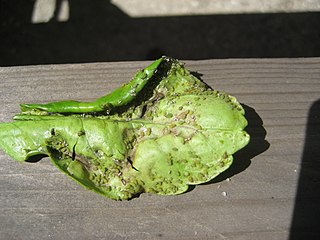
Aphids are small sap-sucking insects and members of the superfamily Aphidoidea. Common names include greenfly and blackfly, although individuals within a species can vary widely in color. The group includes the fluffy white woolly aphids. A typical life cycle involves flightless females giving live birth to female nymphs—who may also be already pregnant, an adaptation scientists call telescoping generations—without the involvement of males. Maturing rapidly, females breed profusely so that the number of these insects multiplies quickly. Winged females may develop later in the season, allowing the insects to colonize new plants. In temperate regions, a phase of sexual reproduction occurs in the autumn, with the insects often overwintering as eggs.

Hemiptera is an order of insects, commonly called true bugs, comprising over 80,000 species within groups such as the cicadas, aphids, planthoppers, leafhoppers, assassin bugs, bed bugs, and shield bugs. They range in size from 1 mm (0.04 in) to around 15 cm (6 in), and share a common arrangement of piercing-sucking mouthparts. The name "true bugs" is often limited to the suborder Heteroptera.

Whiteflies are Hemipterans that typically feed on the undersides of plant leaves. They comprise the family Aleyrodidae, the only family in the superfamily Aleyrodoidea. More than 1550 species have been described.

The Aphididae are a very large insect family in the aphid superfamily (Aphidoidea), of the order Hemiptera. These insects suck the sap from plant leaves. Several thousand species are placed in this family, many of which are considered plant/crop pests. They are the family of insects containing most plant virus vectors with the green peach aphid being one of the most prevalent and indiscriminate carriers.

Woolly aphids are sap-sucking insects that produce a filamentous waxy white covering which resembles cotton or wool. The adults are winged and move to new locations where they lay egg masses. The nymphs often form large cottony masses on twigs, for protection from predators.

Trialeurodes vaporariorum, commonly known as the glasshouse whitefly or greenhouse whitefly, is an insect that inhabits the world's temperate regions. Like various other whiteflies, it is a primary insect pest of many fruit, vegetable and ornamental crops. It is frequently found in glasshouses (greenhouses), polytunnels, and other protected horticultural environments. Adults are 1–2 mm in length, with yellowish bodies and four wax-coated wings held near parallel to the leaf surface.

Aonidiella aurantii or red scale is an armored scale insect and a major pest of citrus. It is thought to be a native of South China but has been widely dispersed by the agency of man through the movement of infected plant material. In the United States it is known as California red scale. It was first found in California between 1868 and 1875, apparently brought there on planting material imported from Australia.

Cinara cupressi, the cypress aphid, is a brownish soft-bodied aphid. It sucks sap from twigs of conifers, and can cause damage to the tree, ranging from discoloring of the affected twig to the death of the tree. This insect appears to have originated in the Middle East and has been increasing its range and is considered to be an invasive species in Africa and Europe. It has been included in the List of the world's 100 worst invasive species.

Coccus viridis is a soft scale insect in the family Coccidae with a wide host range. It is commonly known as green scale or sometimes coffee green scale because it is a major pest of coffee crops throughout the world.

Trioza erytreae, the African citrus psyllid, is a sap-sucking insect, a hemipteran bug in the family Triozidae. It is an important pest of citrus, being one of only two known vectors of the serious citrus disease, huanglongbing or citrus greening disease. It is widely distributed in Africa. The other vector is the Asian citrus psyllid, Diaphorina citri.

Planococcus citri, commonly known as the citrus mealybug, is a species of mealybugs native to Asia. It has been introduced to the rest of the world, including Europe, the Americas, and Oceania, as an agricultural pest. It is associated with citrus, but it attacks a wide range of crop plants, ornamental plants, and wild flora.

Aphis pomi, commonly known as the apple aphid, or the green apple aphid, is a true bug in the family Aphididae. It is found on young growth of apple trees and on other members of the rose family where it feeds by sucking sap. Reproduction is mainly by parthenogenesis, in which unmated females give birth to live young.

Eriosoma lanigerum, the woolly apple aphid, woolly aphid or American blight, is an aphid in the superfamily Aphidoidea in the order Hemiptera. It is a true bug and sucks sap from plants.

Anthocoris nemoralis is a true bug in the family Anthocoridae. The species is native to Europe and is introduced in North America. It is a predator of aphids, spider mites and jumping plant lice, and is therefore used as a biological pest control agent.
Deraeocoris brevis is a species of predatory plant bug in the family Miridae. It is native to North America where it feeds on plant pests in apple and pear orchards.
Cacopsylla pyricola, commonly known as the pear sucker, is a true bug in the family Psyllidae and is a pest of pear trees (Pyrus). It originated in Europe, was introduced to the United States in the early nineteenth century and spread across the country in the next century.
Rhynocoris marginatus is a species of assassin bug in the family Reduviidae. It is a predator of other insects and is found in Asia. Crops in India on which it has been found feeding on pests include sugarcane, pigeon pea, cardamom, cotton, tea, and peanuts. The insects are potentially useful in biological control because they are more resistant to pesticides than are the pests on which they feed.
Pyrilla perpusilla, commonly known as the sugarcane planthopper, is a planthopper in the family Lophopidae. It is native to Asia where it feeds on grasses and other plants and is a major pest of sugarcane and sorghum.

Toumeyella parvicornis is a soft scale insect in the family Coccidae with a wide host range. It is commonly known as pine tortoise scale because of the characteristic appearance of the mature females, which look like tiny tortoises 4–5mm long.

Orchamoplatus citri, commonly known as the Australian citrus whitefly, is a whitefly species in the genus Orchamoplatus. It is found across Australia and New Zealand, primarily foraging on the leaves of citrus trees.
















